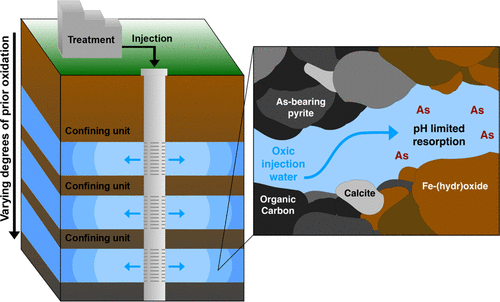当前位置:
X-MOL 学术
›
Environ. Sci. Technol.
›
论文详情
Our official English website, www.x-mol.net, welcomes your
feedback! (Note: you will need to create a separate account there.)
Controlling Arsenic Mobilization during Managed Aquifer Recharge: The Role of Sediment Heterogeneity.
Environmental Science & Technology ( IF 10.8 ) Pub Date : 2020-06-09 , DOI: 10.1021/acs.est.0c00794 Sarah Fakhreddine 1 , Henning Prommer 2, 3 , Steven M Gorelick 1 , Jason Dadakis 4 , Scott Fendorf 1
Environmental Science & Technology ( IF 10.8 ) Pub Date : 2020-06-09 , DOI: 10.1021/acs.est.0c00794 Sarah Fakhreddine 1 , Henning Prommer 2, 3 , Steven M Gorelick 1 , Jason Dadakis 4 , Scott Fendorf 1
Affiliation

|
Managed aquifer recharge (MAR) enhances freshwater security and augments local groundwater supplies. However, geochemical and hydrological shifts during MAR can release toxic, geogenic contaminants from sediments to groundwater, threatening the viability of MAR as a water management strategy. Using reactive transport modeling coupled with aquifer analyses and measured water chemistry, we investigate the causal mechanisms of arsenic release during MAR via injection in the Orange County Groundwater Basin. Here, injection water is oxygenated, highly purified recycled water produced by advanced water treatment. Injection occurs via a well screened at several depth intervals ranging from 160–365 m, allowing recharge into multiple confined horizons (zones) of the aquifer system. However, these zones are characterized by varying degrees of prior oxidation due to historic, long-term infiltration from the overlying aquifer. The resulting sediment geochemical heterogeneity provides a critical control on the release (or retention) of arsenic. In zones with prior oxidation, As mobilization occurs via arsenate desorption from Fe-(hydr)oxides, primarily associated with shifts in pH; within zones that remain reduced prior to injection, As release is attributed to the oxidative dissolution of As-bearing pyrite. We find that As release can be attributed to various geochemical mechanisms within a single injection well owing to geochemical heterogeneity across the aquifer system.
中文翻译:

控制含水层补给过程中的砷动员:泥沙非均质性的作用。
有管理的含水层补给(MAR)增强了淡水的安全性并增加了当地的地下水供应。但是,MAR的地球化学和水文变化会从沉积物中释放出有毒的地质成因,释放到地下水中,从而威胁到MAR作为水管理策略的可行性。使用反应性输运模型,结合含水层分析和测得的水化学,我们研究了橙县地下水盆地注入期间MAR释放砷的原因。在这里,注入水是通过高级水处理而产生的含氧高纯循环水。注入是通过在160-365 m的几个深度间隔内进行筛选的井进行的,从而可以补给到含水层系统的多个封闭层位(区域)中。然而,这些区域的特征是由于上覆含水层的历史性,长期渗透作用,导致事先氧化程度不同。产生的沉积物地球化学异质性对砷的释放(或保留)提供了关键控制。在具有先验氧化的区域中,As的迁移是通过砷从Fe-(氢氧化)氧化物中脱附而发生的,这主要与pH的变化有关。在注入前仍保持还原的区域内,砷的释放归因于含砷黄铁矿的氧化溶解。我们发现,由于整个含水层系统的地球化学异质性,As释放可以归因于单次注入井内的各种地球化学机制。产生的沉积物地球化学异质性对砷的释放(或保留)提供了关键控制。在具有先验氧化的区域中,As的迁移是通过砷从Fe-(氢氧化)氧化物中脱附而发生的,这主要与pH的变化有关。在注入前仍保持还原的区域内,砷的释放归因于含砷黄铁矿的氧化溶解。我们发现,由于整个含水层系统的地球化学异质性,As释放可以归因于单次注入井内的各种地球化学机制。产生的沉积物地球化学异质性对砷的释放(或保留)提供了关键控制。在具有先验氧化的区域中,As的迁移是通过砷从Fe-(氢氧化)氧化物中脱附而发生的,这主要与pH的变化有关。在注入前仍保持还原的区域内,砷的释放归因于含砷黄铁矿的氧化溶解。我们发现,由于整个含水层系统的地球化学异质性,As释放可以归因于单次注入井内的各种地球化学机制。
更新日期:2020-07-21
中文翻译:

控制含水层补给过程中的砷动员:泥沙非均质性的作用。
有管理的含水层补给(MAR)增强了淡水的安全性并增加了当地的地下水供应。但是,MAR的地球化学和水文变化会从沉积物中释放出有毒的地质成因,释放到地下水中,从而威胁到MAR作为水管理策略的可行性。使用反应性输运模型,结合含水层分析和测得的水化学,我们研究了橙县地下水盆地注入期间MAR释放砷的原因。在这里,注入水是通过高级水处理而产生的含氧高纯循环水。注入是通过在160-365 m的几个深度间隔内进行筛选的井进行的,从而可以补给到含水层系统的多个封闭层位(区域)中。然而,这些区域的特征是由于上覆含水层的历史性,长期渗透作用,导致事先氧化程度不同。产生的沉积物地球化学异质性对砷的释放(或保留)提供了关键控制。在具有先验氧化的区域中,As的迁移是通过砷从Fe-(氢氧化)氧化物中脱附而发生的,这主要与pH的变化有关。在注入前仍保持还原的区域内,砷的释放归因于含砷黄铁矿的氧化溶解。我们发现,由于整个含水层系统的地球化学异质性,As释放可以归因于单次注入井内的各种地球化学机制。产生的沉积物地球化学异质性对砷的释放(或保留)提供了关键控制。在具有先验氧化的区域中,As的迁移是通过砷从Fe-(氢氧化)氧化物中脱附而发生的,这主要与pH的变化有关。在注入前仍保持还原的区域内,砷的释放归因于含砷黄铁矿的氧化溶解。我们发现,由于整个含水层系统的地球化学异质性,As释放可以归因于单次注入井内的各种地球化学机制。产生的沉积物地球化学异质性对砷的释放(或保留)提供了关键控制。在具有先验氧化的区域中,As的迁移是通过砷从Fe-(氢氧化)氧化物中脱附而发生的,这主要与pH的变化有关。在注入前仍保持还原的区域内,砷的释放归因于含砷黄铁矿的氧化溶解。我们发现,由于整个含水层系统的地球化学异质性,As释放可以归因于单次注入井内的各种地球化学机制。











































 京公网安备 11010802027423号
京公网安备 11010802027423号